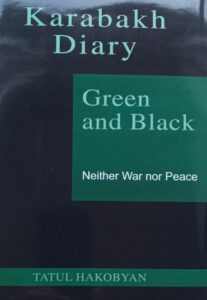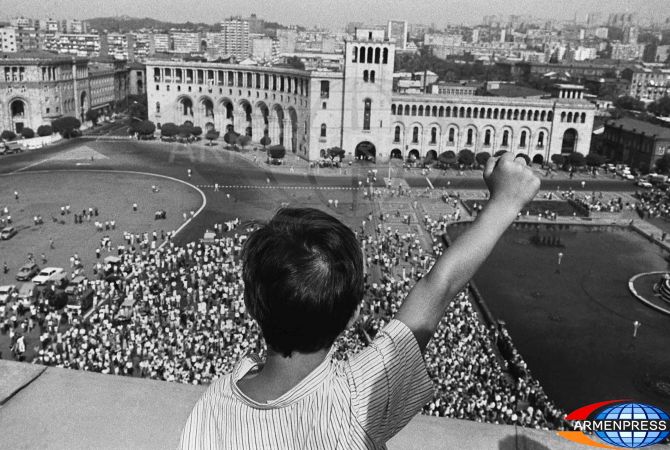From 1965, April 24 was commemorated in Armenia. Unlike in the Diaspora, the press did not pay too much attention to this event. And so, in the April 24, 1988 issue of the official Sovetakan Hayastan newspaper there was not even a single line concerning the genocide. On the first page of the April 26 publication of the paper, there was a short item, without a picture, “Visit to the Tzitzernakabert Memorial”, in which it was said that, “On April 24 thousands of Yerevan residents visited Tsitsernakabert and laid wreaths and flowers in memory of the 1915 victims and honoured the memory of the genocide victims with one minute’s silence.” Armenia’s communist leaders, headed by First Secretary Karen Demirjyan, were among the visitors.
One year later, in 1989, Soviet Armenia’s leadership, thus also the media attached more importance to April 24. One of the reasons was that on November 22, 1988, the Supreme Soviet of the Armenian SSR adopted a law condemning the Armenian Genocide. On April 24, 1989, in addition to the Armenian communist leadership, Vazgen I, the Catholicos of All Armenians, Garegin II, the Catholicos of the Great House of Cilicia, and USSR Deputy Prime Minister Silayev were also among those visiting Tsitsernakabert.
On January 8, 1990, the Central Committee Bureau of Armenia’s Communist Party examined the issue of preparatory activities and events dedicated to the 75th anniversary of the Armenian Genocide. “As a result of the Armenian Genocide, Western Armenia lost all of its local residents, and those Western Armenians who survived were scattered around the world,” said the Bureau’s announcement. Apart from that, the Bureau accepted the suggestion of the Academy of Sciences of the Armenian SSR to hold an academic conference in the second half of April 1990 in Yerevan “concerning the issue of the Armenian Genocide in Ottoman Turkey, with the participation of Soviet and foreign experts.”
In essence, the tradition to commemorate the Armenian Genocide every five years with international conferences was started on the initiative of Armenian communists. Moreover, Vladimir Movsisyan, the First Secretary of the Central Committee of the Communist Party of Armenia was the first to publicly emphasise the necessity of having an Armenian Genocide Museum-Institute.
During his speech at the international conference entitled, “The Armenian Genocide: History, Theory, Political Responsibility” held in Yerevan on April 17-20, 1990, Movsisyan said, “It is necessary to create an international academic research institute in Yerevan, within the system of the USSR Academy of Sciences, for the study of the Armenian Genocide”. An evening memorial event was also held in the Sport and Concert Complexat Tsitsernakabert, during which Movsisyan and the Catholicos of All Armenians, Vazgen I, delivered speeches.
All four pages of the April 24, 1990, issue of the newspaper Khorhrdayin Hayastan were dedicated to the Armenian Genocide. US President George Bush’s statement about the “horrible massacres” of 1915-1923 was also printed on the first page. Among US Presidents, Bush Sr. was the first to address the Armenians in America on the occasion of April 24. Turkey conveyed its disappointment following Bush’s “painful announcement” through its Foreign Affairs Ministry and President Özal. Ankara noted that the announcement contradicted the spirit of the relations between the USA and Turkey. In response, the White House stressed that the statement was not directed towards present-day Turkey.
During a speech in parliament, Vladimir Movsisyan declared that, during the 1920s, “all international treaties and state and party decisions signed behind our nation’s back and violating its national interests must be reviewed and annulled,” adding, “Parliament must demand rights on a state level to defend the Armenian Cause and achieve international recognition of the 1915 Genocide.”
On August 4, 1990, Armenia’s parliament elected Ter-Petrosyan as chairman and, on the 23rd, adopted the Declaration on Independence. There were some points in their drafts that, one way or another, related to Armenian-Turkish relations, the Armenian Genocide, and the Armenian Cause.
From the dozen or so drafts of the Declaration on Independence, the relevant parliamentary committee presented three versions to be discussed by the members of parliament. In one of the versions it said that, “The December 2, 1920, [Alexandrapol] Treaty was forced on Armenia,” after the signing of which Russia and Turkey “occupied Armenia” and, “On March 16, 1921, ignoring the existence of independent Armenia and violating international legal norms, the Russian-Turkish [Moscow] Treaty was signed without the representatives of Armenia, by which the majority of Armenia’s territories were given to Turkey and Azerbaijan”.
One of the drafts proposed “recognising treaties dividing” the Republic of Armenia “as illegal” and also to “once again adopt the Treaty of Sèvres.” In the third version, no reference whatsoever was made to the Armenian Cause and the genocide. In one of its August issues, Khorhrdayin Hayastan published the draft of the declaration presented by the Republican Party of Armenia, in which there was not one word about 1915.
After the three versions, the special parliamentary committee presented a new version for the draft of the declaration which was comprised of eleven clauses, in which once again there was no mention of 1915. Committee member Mekhak Gabrielyan suggested adding the following after the tenth clause: “Consider all agreements signed by Soviet Armenia and all agreements and decisions made by party organs concerning it and signed without the participation of Soviet Armenia, from December 2, 1920 until 1923, to be void and illegal.” Four other committee members suggested the following: “The Republic of Armenia supports the demands of all Armenians around the world for international condemnation and punishment for the 1915 Armenian Genocide in Ottoman Turkey and Western Armenia.”
Raphael Ishkhanyan, MP at the time, writes, “The longest debate was about mentioning our greatest tragedy of 1915 in the declaration. Ter-Petrosyan explained convincingly that including the issue of the genocide in Armenia’s Declaration on Independence is not appropriate from both the political and diplomatic point of view, and that it can be referred to in another document. Six or seven other parliament members brought forward the same argument. But primitive Armenian sentiment once again defeated reason. Grandiloquent speeches were made on behalf of the Diaspora on how we could forget our victims, and how not mentioning 1915 in the declaration is treacherous. Only 25 members of parliament voted against mentioning 1915 in Armenia’s Declaration on Independence.”
In the Declaration on Independence adopted on August 23, 1990, which was signed by Ter-Petrosyan, the Chairman of the Supreme Soviet or parliament, it was noted, “Armenia stands in support of the task of achieving international recognition of the 1915 Genocide in Ottoman Turkey and Western Armenia.”
Official Ankara and Turkish diplomats also pointed out this very point and, by turning it into a pretext, refused to establish diplomatic relations with Armenia.
This piece is from Tatul Hakobyan‘s book – ARMENIANS and TURKS














